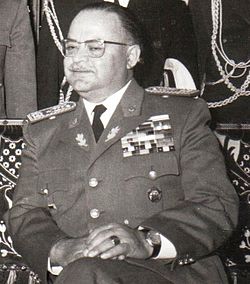Guillermo Rodríguez (politician)
This article has multiple issues. Please help improve it or discuss these issues on the talk page. (Learn how and when to remove these messages)
|
Guillermo Rodríguez | |
|---|---|
 Rodríguez in 1973 | |
| Acting President of Ecuador | |
| In office 15 February 1972 – 11 January 1976 | |
| Preceded by | José María Velasco Ibarra |
| Succeeded by | Alfredo Poveda |
| Personal details | |
| Born | 4 November 1923 Pujilí, Cotopaxi, Ecuador |
| Spouse | |
| Children | 5 |
| Alma mater | School of the Americas |
| Signature | |
| Military service | |
| Allegiance | |
| Branch/service | |
| Commands | Ecuadorian Army |
| Battles/wars | El Carnavalazo coup |
Guillermo Antonio Rodríguez Lara (born 4 November 1923) is an Ecuadorian former political and military leader who was dictator of Ecuador from 15 February 1972 to 11 January 1976.[1] He came to power after leading the 1972 military coup against President José María Velasco Ibarra.[2] He characterized his government as "revolutionary and nationalistic."[2]
Biography
[edit]Rodríguez was born in Pujilí, Cotopaxi on 4 November 1923.[3][4] He took courses in C&R&Bn Staff, Irregular Warfare Orientation, and Maintenance Management at the School of the Americas located in Panama.
As commander of the army, he led a military coup d'etat executed by a navy commander named Jorge Queirolo G. and forced president José María Velasco into exile, to Buenos Aires, Argentina. During his rule, Ecuador experienced substantial economic growth due to a increase in oil prices.[2] The oil wealth enabled his administration to embark on public works programs, funding the construction of hospitals, schools, roads (notably, paving the Quito-Tulcán road), the oil refinery at Esmeraldas, and new equipment for the armed services.[5][2] Some military officers attempted an unsuccessful coup against him in 1975.[2] The Ecuadorian military removed him from power in January 1976.[6][2]
Rodríguez turned 100 on 4 November 2023.[7] He is now the oldest living former state leader in the world.[8]
References
[edit]- ^ Martz, John D. (1987). Politics and Petroleum in Ecuador. Transaction Publishers. p. 29. ISBN 978-1-4128-3133-8.
- ^ a b c d e f Mora, Enrique Ayala (1991), Bethell, Leslie (ed.), "Ecuador since 1930", The Cambridge History of Latin America: Volume 8: Latin America since 1930: Spanish South America, vol. 8, Cambridge University Press, pp. 687–726, doi:10.1017/chol9780521266529.013, ISBN 978-0-521-26652-9
- ^ Lentz, Harris M. (4 February 2014). Heads of States and Governments Since 1945. Routledge. p. 239. ISBN 978-1-134-26490-2. Retrieved 13 October 2023.
- ^ The International Who's Who: 1996–97. Europa Publications. 1996. p. 1313. ISBN 978-1-85743-021-9. Retrieved 13 October 2023.
- ^ Lauderbaugh, George (2012). The History of Ecuador. ABC-CLIO. p. 132. ISBN 978-0-313-36250-7. Retrieved 24 September 2021.
- ^ Martz, p. 6
- ^ El expresidente Guillermo Rodríguez Lara cumple 100 años este 4 de noviembre (in Spanish)
- ^ "Expresidente Guillermo Rodríguez Lara cumplió 101 años". El Universo (in Spanish). 4 November 2024. Retrieved 29 January 2025.
External links
[edit]- Official Website of the Ecuadorian Government about the country President's History[permanent dead link]
- 1923 births
- Living people
- Ecuadorian men centenarians
- People from Pujilí
- Ecuadorian generals
- Presidents of Ecuador
- Leaders who took power by coup
- Leaders ousted by a coup
- Ecuadorian expatriates in Panama
- 20th-century Ecuadorian politicians
- Ecuadorian politician stubs
- South American military personnel stubs
- Ecuadorian people stubs

